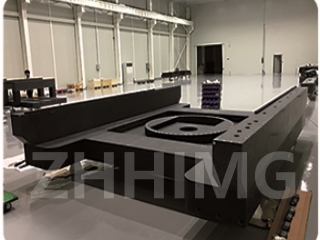In the semiconductor manufacturing process, the use of granite components has been favored by numerous manufacturers. Granite is a type of igneous rock that is mostly composed of quartz, mica, and feldspar minerals. Its properties, which include high dimensional stability, low thermal expansion coefficient, and excellent resistance to chemical corrosion, make it ideal for the manufacturing of semiconductors. In this article, we will discuss the advantages and disadvantages of using granite components in the semiconductor manufacturing process.
Advantages of Granite Components:
1. High Dimensional Stability: Granite has excellent dimensional stability due to its low linear thermal expansion coefficient which makes it an ideal material for precision processing. This makes it the perfect choice for accurate and precise manufacturing of semiconductor components.
2. Good Vibration Damping: Granite's high density and stiffness make it an ideal material for vibration damping which creates a stable and quieter work environment that promotes high-quality output.
3. Excellent Chemical Resistance: Granite's resistance to chemical corrosion, combined with its high hardness, makes it resistant to most chemicals used in the semiconductor industry. This makes it ideal for use as components in corrosive environments.
4. Low Thermal Expansion: Granite's low thermal expansion coefficient makes it an excellent material for use in the semiconductor industry as it minimizes the risk of thermal misalignment of components.
5. Longevity: Granite is an extremely durable material that has a long lifespan, which increases the reliability of the equipment it is used in. This reduces the need for frequent replacements and lowers the overall operating cost of the manufacturing process.
Disadvantages of Granite Components:
1. High Cost: The use of granite components is more expensive than other materials used in the semiconductor manufacturing process. However, with increased longevity, it is a cost-effective investment.
2. Heavyweight: Granite is a heavy material, and its weight makes it difficult to move around during the manufacturing process. It also increases the cost of transportation.
3. Difficult to machine: Granite is a hard material, which makes it difficult to machine. Specialized tools and techniques are required to cut and shape the material, increasing the time and cost of manufacturing.
In conclusion, the advantages of using granite components in the semiconductor manufacturing process outweigh the disadvantages. The material's dimensional stability, resistance to chemical corrosion, and low thermal expansion coefficient make it an ideal choice for manufacturing equipment used in the process. Its durability and longevity also make it a cost-effective investment. While cost, weight, and difficulty in machining are some of the disadvantages, these can be mitigated by taking a long-term view on investment in manufacturing equipment that needs to be reliable, precise, and able to operate in a harsh environment. In short, granite components are an excellent choice for semiconductor manufacturers who prioritize reliability and consistently high-quality output.
Post time: Dec-05-2023

